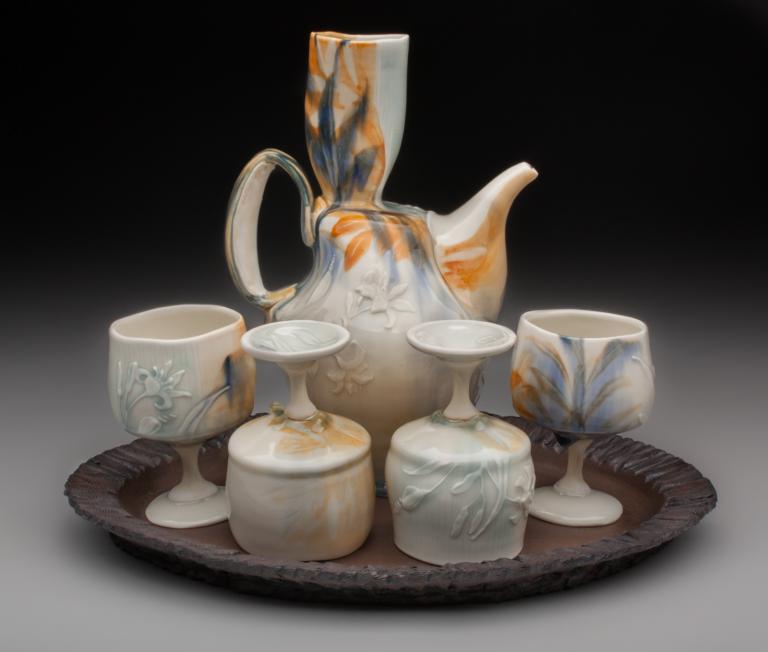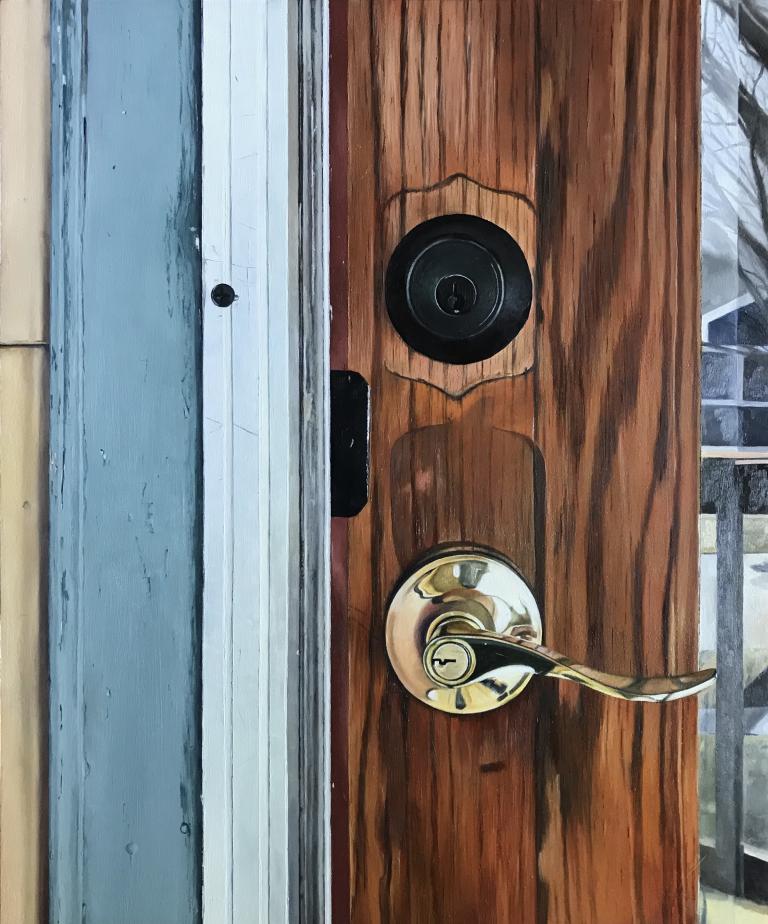
MFA Thesis Exhibitions open March 22
calendar icon15 Mar 2021

Lincoln, Neb.—Eight graduating Master of Fine Arts students in the University of Nebraska–Lincoln’s School of Art, Art History & Design will present their MFA Thesis Exhibitions in the Eisentrager-Howard Gallery in Richards Hall beginning March 22.
The simultaneous solo shows will be on display in four rounds, with a new pairing of artists each week between March 22-April 16.
The first round runs March 22-26 and features the work of Katie Bosley (ceramics) and Julia Leggent (painting). In lieu of an in-person reception, a virtual artist talk and tour with Q&A is scheduled for Thursday, March 25 from 5:30-6:30 p.m. via Zoom at https://go.unl.edu/p7ae(Meeting ID: 972 6796 2923). The gallery will be closed for an oral examination on Wednesday, March 24 from 12:30-2 p.m.
The second round runs March 29-April 2 and features the work of Terry Ratzlaff (photography) and Isaiah Jones (printmaking). In lieu of an in-person reception, the artists are utilizing remote platforms to celebrate with the public. A remote artist talk for Ratzlaff will be hosted via Zoom on Thursday, April 1 at 5:30 p.m. by 2nd year MFA candidate in photography Eddy Aldana. Connect via Zoom at https://go.unl.edu/rft6 (Meeting ID: 968 9612 1842). In addition, Ratzlaff and Jones will present a live tour of their exhibitions via Instagram (@terryratzlaff and @isaiaherinjones) on Friday, April 2 from 5:30-6:30 p.m. The gallery will be closed for an oral examination on Tuesday, March 30 from 11:30 a.m.-1:30 p.m.
The third round runs April 5-9 and features the work of Matt Carlson (sculpture) and Chance Allen (painting). Carlson and Allen will be having remote artists talks on Thursday, April 8 at 5:30 p.m. Connect via Zoom at https://unl.zoom.us/j/98410402807(Meeting ID: 984 1040 2807). The gallery will be closed for oral examinations on Wednesday, April 7 at 8-9 a.m. and 11:30 a.m.-12:30 p.m.
The fourth round runs April 12-16 and features the work of Taylor Sijan (ceramics) and Amythest Warrington (ceramics). The two artists will present a live tour of their exhibitions via Instagram (@taylorsijan and @amythest_the_ceramicist) on Thursday, April 15 after 4:30 p.m. The gallery will be closed for oral examinations on Wednesday, April 14 until 2 p.m. and Thursday, April 15 after 2 p.m.
General hours for the MFA Thesis Exhibitions are Monday–Friday, 12:30-4:30 p.m. or by appointment. Call (402) 472-5522 to make an appointment. The gallery will be closed to all visitors during oral examination times listed above during each round.
The Eisentrager-Howard Gallery is located on the first floor of Richards Hall at Stadium Drive and T streets on the University of Nebraska–Lincoln city campus. Admission is free and open to the public.
Until further notice, all students, faculty, staff, and campus visitors are required to comply with current CDC safety guidelines (social distancing and facial coverings) in response to COVID-19. Details, exclusions and updates can be found at the City of Lincoln’s website at https://app.lincoln.ne.gov/city/covid19/how-to-help.htmand the University of Nebraska–Lincoln website at https://covid19.unl.edu. Additionally, all campus visitors must enter Richards Hall via the north doors if unaccompanied by student, faculty or staff. If greeted by an attendant at the stairs, please call the number below for further assistance.
Please contact the School of Art, Art History & Design for more information, to schedule an appointment, or any assistance getting into the building at (402) 472-5522 or schoolaahd@unl.edu.
Follow the Gallery on social media via Instagram @eisentragerhowardto stay apprised of any updates on these plans.
Below is more information about the artists and their exhibitions.
Julia Leggent| Things Change
Leggent explores the social, political and the feminine through detailed paintings that typically operate at a one-to-one scale to real life. The paintings depict highly rendered parts of the anatomy, objects and domestic space. These true-to-life compositions are filled with miniscule details often left unnoticed. Working from life, as well as photography, Leggent creates paintings that explore topics ranging from personal to universal.
Leggent grew up in the small, one spotlight town of Norton, Kansas, and received her B.F.A. in painting from Fort Hays State University. Leggent’s “Cutting Ties,” was recently awarded 2ndplace in the 2021 Young Painters Competition by the Miami University (Ohio) College of Creative Arts and the Department of Art.
Katie Bosley| Slowly but Surely
Bosley creates objects with presence. She makes porcelain vessels that combine dynamic forms and dimensional surfaces, working to engage positive and negative space as well as light and shadow. By carefully forming and carving her pieces by hand, they speak to the virtuosity of the maker. Symmetrical and precise, Bosley’s vessels are striking at first glance and reward further inspection.
Originally from Clearwater, Florida, Bosley earned her Bachelor of Fine Arts degree in ceramics from the University of Florida. She has interned at the Archie Bray Foundation in Montana and Women’s Studio Workshop in New York. She also spent a year as an Emerging Artist Resident at the Northern Clay Center in Minneapolis.
Isaiah Jones| Devastation Experienced When Two Individuals Stop Kissing One Another
Jones was raised in Western North Carolina, where she spent a great deal of time standing in rivers and walking through the forests. Her work explores love, desire, memory and storytelling.
Terry Ratzlaff| Take Your Time
In his work, Ratzlaff deconstructs and analyzes modern perceptions of time, chaos, order and obsession. In “Take Your Time,” he photographically deconstructs three idiosyncratic characters: a collector of model trains, an accumulator who makes annotations of train activities, and himself—a mimetic assemblage of collectors and accumulators. Each character is represented in its own collection of photographs that visually collide and collude with each other. By coupling each of the characters, Ratzlaff analyzes how obsession organizes a collection with the intent to control the experience of time.
Chance Allen| Short Stories, Tall Tales
Allen makes graphite drawings and oil paintings that depict intimate still lives that are driven by narrative. Real and imagined stories are thrown against tightly structured compositions. The imagery within these still lives combines his personal history as well as other histories such as, art, music, and pop culture. But all of the images draw heavily from the American visual language and iconography.
The still lives are limited in elements and focus on the relationship between the object and image. Using only a few objects forces these pairings into a standoff with one another so that they supersede their literal presence for a new symbolic one. Through this method of storytelling, he explores things like his future death, love, and conflict surrounding family.
Matt Carlson| Tomorrow is the Worst Day Since Yesterday
Carlson uses art to question these structures and examine the role of systems as a method of understanding and navigation. Whether its creating a system of mark making to draw conversations he has with his son, or using the time he spends in a car as the basis to create large-scale drawings, he uses these quotidian experiences as a basis to create art. He aims to draw attention to the aspects of our lives that we, both as individuals and as society, often take for granted, or simply are not recognizing as events that impact our daily lives. He practice includes sculpture, drawing, installation, social practice and experiential art. The emphasis is placed on the process that creates the work, rather than the final product itself.
A native of San Diego, California, Carlson spent his early 20s exploring various areas of the country before settling in North Carolina. There, he earned a B.F.A. in sculpture and ceramics from the University of North Carolina at Greensboro, and an A.A.S. in photography from Randolph Community College. Before arriving in Lincoln, he spent 3 ½ years working alongside people with autism and their families. Advocating for people living with disabilities and their families continues to be important to his life and a driving force behind his work.
Amythest Hultman Warrington| The Weight of it All
Warrington was born in Iowa City, Iowa, but she was raised in a mobile military family growing up around the U.S. and Europe. She received her Bachelor of Fine Art in ceramics with minors in art history and art from the University of Northern Iowa in 2014. While working on her bachelor’s, she studied abroad at the Jingdezhen Ceramic Institute for a semester in Jingdezhen, China, through West Virginia University’s China Program.
Her mobile upbringing taught her that the details may differ from group to group, but the essence or core experiences surrounding loss, empathy and belonging are a universal language connecting us all. Warrington’s work explores the dichotomy between strength and frailty associated with these universal connectors through clay’s unique physical properties of malleability, recyclability and permanence once fired. Her meticulously crafted beautiful objects draw you into serious and often taboo subjects to comfort those who need it, while challenging those that are comfortable and providing a way forward through art.
Taylor Sijan| Growth
Sijan makes functional pottery that is richly decorated with layers of abstracted botanical imagery. As she works, she balances design decisions based on her understanding of aesthetic beauty influenced in the decorative arts, Art Nouveau, and the individualistic usefulness of contemporary American functional art pottery. By making vessels, she aims to connect her reverence for plants, nourishment and beauty with people who then add their own meanings and interpretations to her work after it becomes a part of their life.